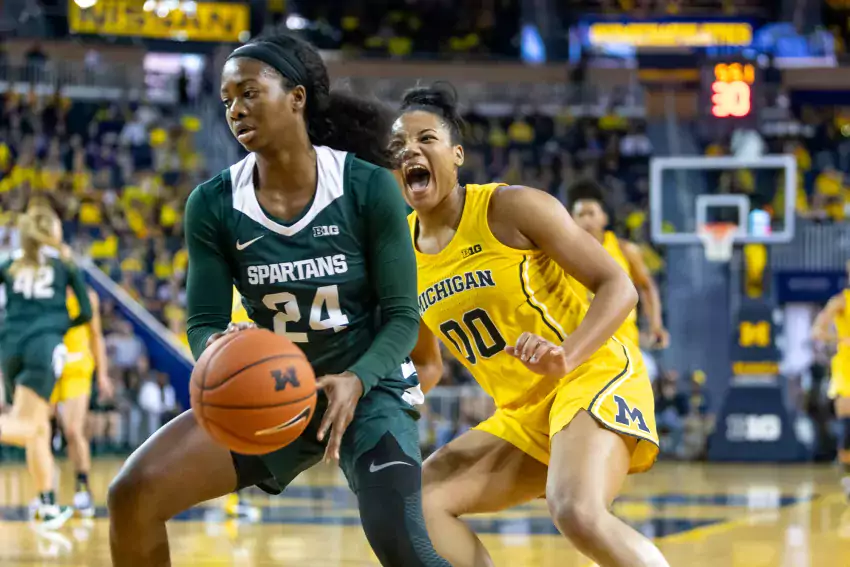
Unverified Voracity Wants To Know Duncan Robinson's Take On The Pale King

Sponsor Note. If you're in the market for high-quality cannabis at reasonable prices and want to feel like you're in a spaceship while shopping, Information Entropy is the place.
They're open until 8 now and provide free delivery. They're also family-owned by locals; Drew is a Michigan alum. Also: 10% off if you mention MGoBlog. I suggest mentioning MGoBlog by sidling up to someone there and whispering it at almost sub-vocal levels. Let's make it weird. This is a good way to keep a sponsor.
POY/COY. Congratulations to Naz Hillmon, the Big Ten's women's basketball player of the year. Hillmon averaged 25 and 11 while shooting 65% from the floor. That'll do. Congratulations are also in order for Juwan Howard, the Sporting News MBB coach of the year.
Yes I will link a retrospective of Trey Burke stealing the ball from Keith Appling. This is a thing I will do:
“As soon as we turned the ball over, I started thinking of ways to get the ball back, like, ‘we’ve gotta get the ball back, or they’re gonna hold for the last shot,’ ” Burke told the Daily in a phone interview this week. “My mind automatically went to getting the steal.”
Matched up against Keith Appling, the Spartans’ star guard, Burke knew what to look for. Appling dribbled the ball up past half-court and turned his head towards Michigan State coach Tom Izzo. As Appling asked for a play call, his right hand was exposed. Despite the Spartans being in the double-bonus, Burke went for the steal.
“I had gotten it on a few other guards that year, but Keith Appling usually wouldn’t leave the ball there,” Burke said. “He usually would spin with the ball in the right hand, with his outside hand, so you can’t get it.”
It's Duncan Robinson content Tuesday. First, a preview of his interview with one half of Men In Blazers cites one DFW:
Inspired by the words of David Foster Wallace, Duncan Robinson explains to Rog how he acts as a "conscious participant" in his own life, on and off the court.
— Men in Blazers (@MenInBlazers) March 8, 2021
The @MiamiHEAT player joins us this WEDNESDAY. @D_Bo20 is proper @ManCityUS. Airs 3:30 pm ET on NBCSN @NBCSportsSoccer. pic.twitter.com/BEFhsaZLoq
I was initially surprised by this and then created a mental list of athletes most likely to cite David Foster Wallace. "Guy who went to Williams" for a year topped it.
Second, how Robinson went from the G-League to an NBA record-setter:
https://www.youtube.com/watch?v=0tOjr9OJxQI
He also tops the most unlikely pro star list.
[After THE JUMP: in which the common sense of the hockey committee is relied upon]
I submit this is Weird. Home court advantage did not budge as much as you'd think:
The regular season is over and to copy a phrase from my friend M. Twain, the demise of home court advantage was greatly exaggerated. Home teams won 57.5% of conference games, with an average margin of 2.45. This beats the previous lows set in '17 (59.0%, 2.79), but not by much!
— Ken Pomeroy (@kenpomeroy) March 8, 2021
Environmental factors clearly play a role. Kenpom's home court advantage leaderboard has an "altitude" column for a reason:
Nine of the top ten teams in altitude have above-average HCAs despite not having the kind of attendance you'd expect moves needles. On average they rank 62nd, and we should really drop the Big Sky teams out since 9 of their 11 teams are 26th or higher in elevation.
Anyone who's gone skiing in the Rockies knows why elevation is an advantage, but I wonder if subtler environmental factors have an impact as well.
Nate Oats in a nutshell
One dollar for Matt Norlander. Or whoever wrote this headline:
Ball & Oats: How Alabama became an SEC powerhouse overnight on its way to possibly changing college basketball
That's a dive into Nate Oats, who has to be the most analytics-inflected coach in America:
Last season, Oats' first with Bama, the Tide led all teams among the Major Seven conferences in percentage of 3-pointers attempted vs. percentage of 2-pointers attempted with 49% of its shots coming from beyond the arc. But it was barely a winning strategy on its own. Alabama finished 16-15 thanks to a suboptimal defense (114th at KenPom) amounting to a middling inaugural season.
Oats and his staff overhauled their defensive accountability in the offseason, improving from a sub-100 unit to top-three. (This is outrageous.) But they also held steadfast in their belief that the 3-point shot could be their meal ticket. A season after 3-pointers accounted for nearly half of its total attempted shots last season, Bama has turned to launching from distance again, with 47.4% of its shots from 3 powering the program's best offense in nearly two decades. Once again, it's a pace well ahead of the rest of the teams in the power conference hierarchy.
Oats's teams play fast and shoot almost exclusively at the rim or from deep. Oates himself is one of he bluntest coaches in the country:
"Modern basketball, you're not catching a ball and putting it on your hip and staring at the defense for five seconds before you do anything. That's not how basketball's played anymore," Oats said. "But I'm sure dad, uncle, grandpa, professional skills trainer, you're gonna do all this mid-range, triple threat, all this old-fashioned garbage."
Oats is a fascinating counterfactual for Michigan basketball since he hails from the state and was a hot name just a couple months before John Beilein left for the Cavaliers. During Michigan's coaching search someone told me that if Michigan really pressed for him they could probably get him—though that would have involved paying a steep buyout for a guy who just moved jobs. Michigan instead went with Juwan Howard, which is going okay.
Anyway, fascinating article in which Oats sits down with his team and does the points-per-possession math to convince them that midrange jumpers are poison.
The gates open, temporarily. The one-time transfer got shelved as a permanent rule change but it sounds like they're going to do it this year anyway:
While the actual legislative proposal status is still TBD, this waiver — for the upcoming year only — will at least allow those to transfer and be eligible right away without having to worry.
— Bryan Fischer (@BryanDFischer) March 8, 2021
This is taking a defacto truth and making it an actual one—some 90% of people were getting waivers the past couple years—but removing even the slight possibility you'll have to sit out is going to take up-transfers from a relatively rare way to patch roster holes to a full-on second recruiting pathway. I have my reservations about what this will do to the frequency of March Madness upsets, but this train is a way to get good PR for the NCAA without spending any money so it will happen.
Probably in? There's been absolutely no guidance from the NCAA about how the hockey tournament will be selected and seeded, but College Hockey News's wild guess is that Michigan is a lock:
Just looking at things practically, there's probably 10 teams that are very safe: North Dakota, St. Cloud State, Minnesota-Duluth, Minnesota, Michigan, Wisconsin, Boston College, Massachusetts, Quinnipiac, Minnesota State.
Here's the thing — without an objective system, there's going to be a lot pressure on the Committee members to take similar amount of teams from each conference. This will not be a mandate so much as human nature.
There are 16 slots in the tournament and six conferences (B10, NCHC, WCHA, ECAC, HE, AH). One of those conferences, Atlantic Hockey, is historically a one-bid conference and will almost certainly get one bid again. A second, the ECAC, is currently operating with four teams since the Ivy League sat this season out. They are unlikely to get multiple bids and definitely won't get three. So that's 13 or 14 slots to distribute between four conferences. It is close to inconceivable the Big Ten won't get three of those and Michigan is clearly #3 in the Big Ten pecking order.
I'm not putting it completely beyond the powers that be in hockey to completely screw this up since this is a new frontier in making the worst possible tournament, but even I have to think that some of the wilder things out there cannot be true:
The Pairwise has Canisius in line for a #1 seed... https://t.co/g88mdHPN1y
— Chris Dilks (@ChrisDilks) February 16, 2021
For one, "strength of schedule" does not exist this year since there is limited or no interconnectivity between conferences. This is why the Pairwise is useless to begin with. "Pairwise will be used" can only mean it will be used to rank teams within conferences. Probably.
A demand for college basketball pairwise. Jesse Newell suggests that the basketball committee should go the way of the dodo:
I’m ready to do away with the NCAA Tournament selection committee, which is a group that means well but is tasked with an impossible assignment each year.
The NCAA, in actuality, is making a mountain out of a molehill when selecting its teams. It has created Team Sheets and NET and Quadrants and endless “scrubbing” sessions when, in fact, all are completely unnecessary for the actual task of putting the most deserving at-large programs into the field each year.
There’s a simpler way to do this, and one that would have far-reaching benefits —perhaps the greatest of which being that it would allow all teams to know exactly where they stand in terms of securing an NCAA bid. …
Every team will know, in the moment, where they are and what they potentially need to do to get into the field as an at-large.
Say, for instance, you are Belmont. As of Monday, you rank 41st in WAB, which would be in line for the first 11 seed.
All of a sudden, there’s clarity with your situation. Win your next four games — which would add a combined 0.11, 0.03, 0.21 and 0.25 to your WAB total — and you’re all but assured to be in regardless of what happens in the conference tournament. Slip up somewhere, and you can re-evaluate from there, knowing that a WAB ranking in the upper-40s or low-50s won’t be guaranteed to make it based on other conference tournament results.
This is less wacky than it seems. WAB is a lot like what the committee does except there aren't cliffs for "quadrants" and home/road stuff is respected. The consensus one seeds are 1-4 in WAB; a WAB top sixteen looks like this, with seed changes from the current Bracket Matrix bolded:
- Gonzaga
- Illinois
- Michigan
- Baylor
- Alabama
- Iowa
- Ohio State
- Arkansas (3 –> 2)
- Purdue (4 –> 3)
- Kansas
- Oklahoma State (4 –> 3)
- Villanova
- Clemson (6 –> 4)
- West Virginia (3 –> 4)
- USC (5 –> 4)
- BYU (7 –> 4)
Houston is gets flung down from a consensus two seed to a 5.
The above is close enough to the actual projected seeding that going to WAB would not be a seismic change at the top of the bracket. Only three teams in the top 16 of WAB or the current bracket matrix move more than one seed line.
At the bottom things wouldn't be entirely different but there would be some big outliers. Oklahoma, currently a 6 in the Bracket Matrix but 47th in WAB, would be at risk of getting booted from the tournament entirely.
The usual. More 2021 NHL draft rankings from Scott Wheeler include a quote from Bill Muckalt on Kent Johnson:
Wolverines associate head coach Bill Muckalt on Johnson: “Kent is uber skilled. It’s hard for me to give an honest assessment of the other players but I would have a hard time believing there’s anybody more skilled offensively than Kent Johnson in this draft. The shit he does offensively, you only see it once every four or five years. But he’s physically the least mature of our freshman as far as our strength and he’s playing against guys some nights that are seven-to-eight years older, so it makes it difficult on him. But he does highlight reel stuff. Where (Matt) Beniers has this motor that is just 200 feet, Kent is more artistic and creative, and more high-risk. But he’s going to be like a (Elias) Pettersson or a (Patrick) Kane.”
If I had to pick one guy to get back next year it would be Johnson, who has the best chance of blowing up into a slam-dunk Hobey winner. (Unless there is a guy from Harvard who happens to be a senior and scores 23 points.)
Michigan guys on Wheeler's list: #1 Owen Power, #2 Kent Johnson, #4 Luke Hughes, #5 Matt Beniers, #27 Dylan Duke, #32 Matt Samoskevich.
Etc.: Pete Sampson on Louis Nix. RIP. Chris Peters's listing of top college hockey rookies is naturally heavy on Michigan players. A Clint Dempsey story. A good tweet. Everyone hates Bo Borowski. Will Tschetter profiled. It was only a matter of time before Ann Arbor politics got to the dried pig fetus stage.
For the hockey tournament selection, Michigan fans need to look with terror on what happened in the women's hockey tournament, where Minnesota was left out and instead a less qualified Minnesota-Duluth team was selected from the WCHA, and a less qualified Eastern team was selected as well. Minnesota-Duluth had a member on the NCAA women's hockey selection committee, and the rest of the committee was from out East. Coincidence? It's unlikely.
On the men's side, look for how they treat The University of Nebraska at Omaha and Robert Morris, who are both bubble teams who should be out but have representatives on the committee, vs how they treat Michigan.
Given how NCAA post season play has been handled for the entire time I've followed the sport, I wouldn't be shocked if they left us out for some 2nd place Atlantic Hockey team. Sometimes I think the people running NCAA hockey are trying to destroy it from the inside
Bo Boroski looks like a future bodybag occupant on the Sopranos. How do these morons keep landing high profile jobs?
Eh, if Greg Gard - coach of Brad "Elbowing is a basketball play" Davison - hates Borowski, maybe he's not all bad.
An Illinois hoops fan site put out an awesome troll job video on Gard. They interspersed his comments about Davison getting a raw deal with clips of Davison nut-punching 3 different dudes. Davison should have been expelled from the league. Three strikes (to the nuts) and you’re out. That should be a new rule. We can call it the Brad Davison rule.
March 10th, 2021 at 11:31 AM ^
Siding with Borowski to hate on Gard is cutting off your nose to spite your face, or winning the battle but losing the war, or some other metaphor. Gard may suck and be at least partially responsible for Davidson's dirty play, but Borowski ruins games across the whole conference.
It is kind of weird that everyone hates Bo Boroski, he is the 3rd ranked official nationally and the best in the B1G according to Kenpom:
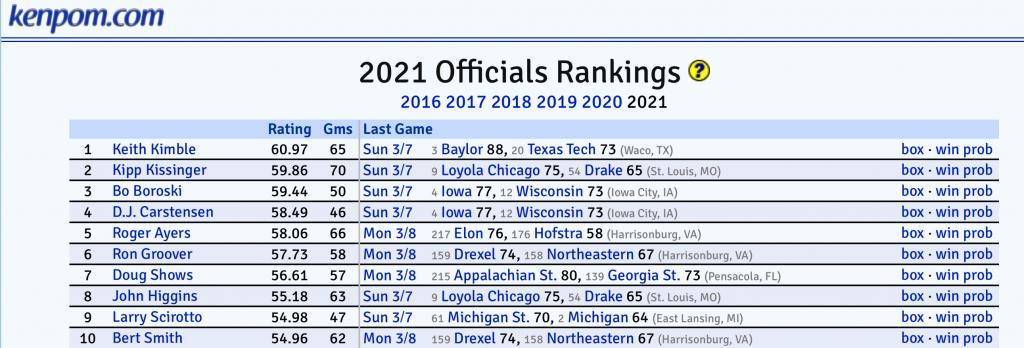
The KenPom ref rankings are nothing more than an amalgamation of how many (and the types of) assignments a ref is given. They have nothing to do with the actual quality of the refs’ calls.
I love using WAB as a single metric. If it's a transparent formula, I feel like the smaller teams will have a much more clear understanding of what they need to do to make the field.
I think the biggest reason that won't happen is that there is a huge industry around bracketology that drives a ton of interest in the tournament that would be killed by this.
Is there really a huge industry centered on predicting who will be in the tournament? There is Joe Lunardi (who has a separate day job) and...?
And... ESPN, CBS, Fox, et all regularly report on who stands where in bracketology. You can't watch a game, or highlights, or Sportscenter without seeing an update. There are commercials touting it.
Even if it's only Joe Lunardi, the interest generated is free advertising that the NCAA gobbles up. Enough free advertising that it could qualify as an 'industry'...
Ok but you could just replace that stuff with WAB analysis. Oh look this team needs to win these games, can afford a loss here, etc.
A single metric would be great, but power conferences are the reason why it’s unlikely to happen. It only would hurt them.
If you’re a big-name team that’s having an objectively strong season, the subjective measures (polls, awards and ultimately NCAA inclusion/seeding) will reflect that. If a big-name team is having a decent season, the subjective measures still might call it good or great. MSU being in most brackets before the Michigan split despite a NET in the high 60s is a good example of this. So is the Oklahoma one above.
Non-power high seeds like Houston might get dinged in an objective system, but if you’re a power-conference coach, moving up a seed line at Houston’s expense doesn’t mean all that much. What’s meaningful is the committee saving your bacon and putting you in the tournament on a judgment call.
I think you’re burying the lede. Ann Arbor’s police chief is Mike Cox?!?
Before selecting Cox they almost chose Mike Hunt as Chief, but thought better of it ?♂️
Oats will be interesting to watch. I followed some of his good UB teams closely and I always thought they looked undisciplined and out of control, but that was UB with UB talent. If he's figured out defense, maybe his system is maturing a bit and he'll make some noise down there. I'll watch with intrigue
Still glad we got Howard. I'm not entirely sold on Oats yet
You're right, it will be interesting (as success tends to be influential) but I won't be watching it -- one thing I can't stand about the modern game is jacking 3's every other shot. I completely understand why it is being done, from a pure numbers perspective, but I largely stopped watching college basketball in the late 90s for about 10 years for two reasons: 1) Michigan wasn't any good and 2) MSU, Wisconsin and the rest were putting up 40-38 games that were slogs.
While Alabama scores a lot more, they shoot 35% from 3. That means in most games, they are missing 60% of their total shots, and I don't enjoy basketball where missing that many shots are the norm. It is also repetitive (there are just basically two types of shots: 3s and at the rim 2s) and thus less interesting to me.
Yeah, I've caught a couple of Alabama's games and thought they were helped by the SEC being sort of hot garbage this year. Like, their #3 defensive rating in KenPom feels unbelievable, much like Loyola-Chicago being #1 in that department. I don't know what to make of it but I'm not sold Oates's approach will lead to consistent high results for them.
Newell's suggestion makes objective sense, but part of me likes that there is a bit of mystery as to what the selection committee is looking for, so teams don't know exactly what they need to do or what region they will end up in. The drama of Selection Sunday is fun.
Would we really want to lose this?
YES. YES. YES. A million times, YES. Hate to be so harsh, but answering the question of whether or not a 19-12 team that finished 7th in the conference gets a shot to be an 11 seed is not drama.
It never ceases to amaze me how we transition from college football and debates about who the top 4 teams are, to college hoops and "debates' about who the 64th and 65th best teams are and we treat them with nearly the same emotion, passion, and importance. Makes ZERO sense.
Re:Home Court, I maintain that COVID-safe travel protocols (while super important!) have to add stress to the visiting team and could be better or worse for them than having fans. Early stories talked about the time it takes to load the bus since hotel elevators were limited to 2 people at a time, or lack of team meals prior to games, etc.
Granted, this may have been a bigger factor earlier in the season than now, as teams are used to their protocols.
Generalizing on this, I think you could probably build a case for travel time/travel fatigue being a primary factor in home court advantage. Altitude likely matters on its own, but it could also partly proxy for travel fatigue -- higher altitude western teams are also probably farther away on average from their opponents.
That Oats chart reminded me of this NBA graph from last year
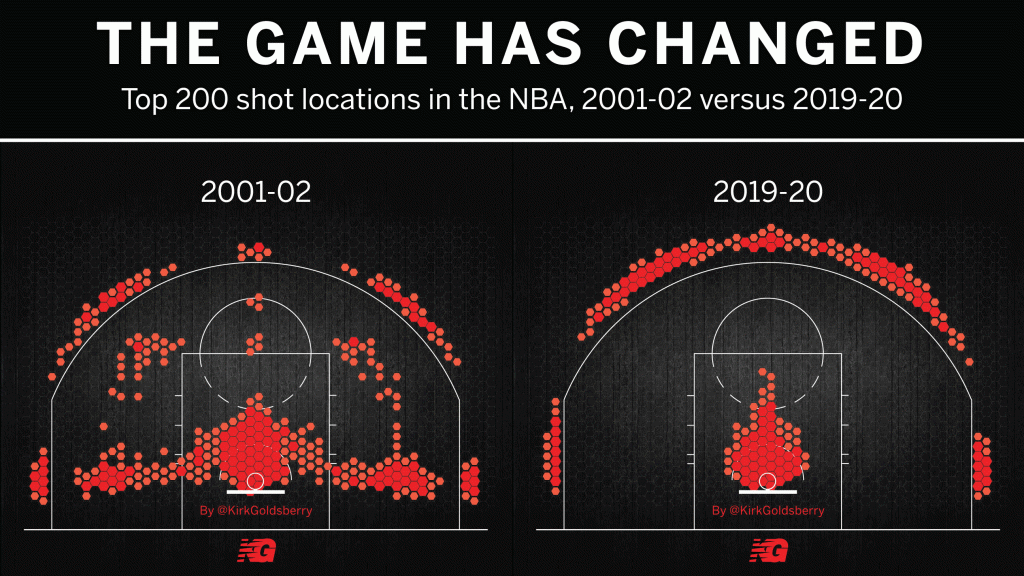
Good thing Antonio McDyess played when he did, because his go to shot is GONE. If I close my eyes I can still picture him hitting turn around baseline 2pt jumpers in those lightning bolt Pistons alternative uniforms.
Wasn't there talk about the NHL not doing a draft this year and 2 the following year that may allow all of our guys to come back?
Featured photo: Not Duncan Robinson
I'm not saying that Alabama hasn't improved as a defense but Kenpom's top-5 defenses are:
- Loyola-Chicago
- Memphis
- Alabama
- Michigan
- Tennessee
I've not watched all of the games for 4 of these 5 teams, but I'm slightly dubious that two SEC teams have top-5 defenses and the nation's #1 team doesn't have a guy taller than 6-9.
KenPom does take SOS into account so if it looks wonky because they don't have the sexy names there then it's your problem IMO.
Well, SoS only works if you have a significant mixture of in-conference and out-of-conference teams in order to best assess performance across the country. When you don't you can have some really disjointed results, such as the fact that Loyola's #1 defense came against the #133rd adjusted opponent offenses. Also, the fact that 2 of the 4 times they gave up over a point per possession was against Wisconsin and Richmond, two non-conference teams (and both losses), and one of the other times was against Drake, the #1 offense in their conference. So no, I don't think it's particularly crazy to wonder if scheduling may have something to do with some of these rankings.
I'm not saying they aren't a perfectly good defense, but both Loyola Chicago and Alabama were significantly worse on defense last year and without massive roster turnover suddenly have top-5 units per the advanced stats this year feels a bit like pandemic-altered numbers.
March 10th, 2021 at 10:24 AM ^
Or they have improved in one off-season. Like Michigan suddenly went from average at best defense under Beilein to among nation's best defensive team. Change the name from Michigan to Loyola Chicago or Alabama, you're saying the same thing.
WABbit season?
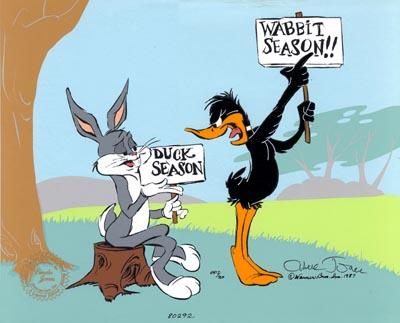
Isn't Matt Patricia an analytics guy?
point is - let's see if nate oats can keep it going.

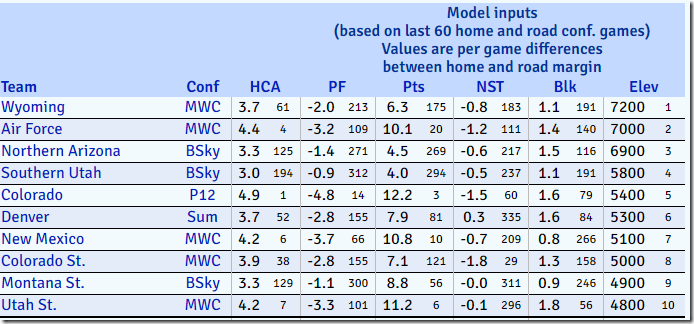
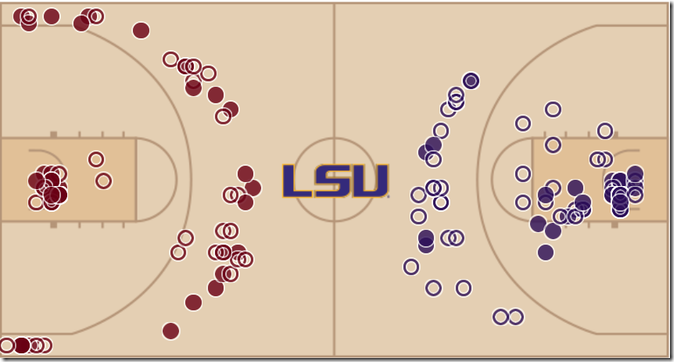
Comments